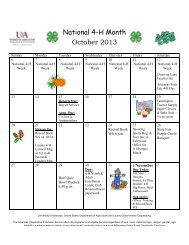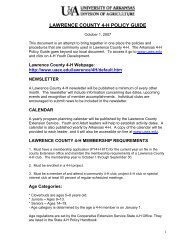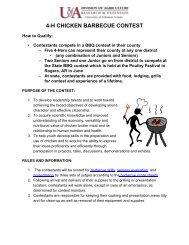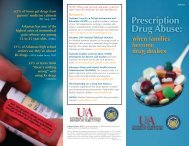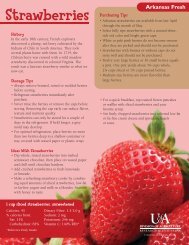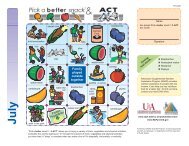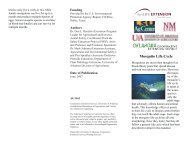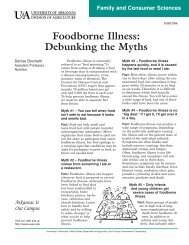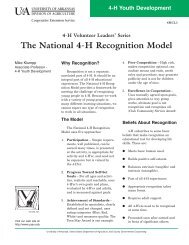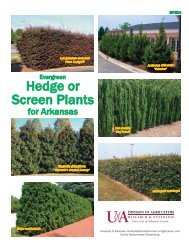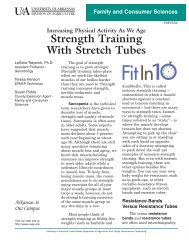Tarnished Plant Bug - University of Arkansas Cooperative Extension ...
Tarnished Plant Bug - University of Arkansas Cooperative Extension ...
Tarnished Plant Bug - University of Arkansas Cooperative Extension ...
You also want an ePaper? Increase the reach of your titles
YUMPU automatically turns print PDFs into web optimized ePapers that Google loves.
MULTISTATE EVALUATION<br />
<strong>of</strong> <strong>Tarnished</strong> <strong>Plant</strong> <strong>Bug</strong><br />
Sampling Methods<br />
in Blooming Cotton<br />
MP471<br />
Pub. # 2945 LSU AgCenter
Fig. 1 - Immature tarnished plant bug.<br />
Introduction<br />
Cotton pest management has undergone significant<br />
changes since the mid 1990s. Extensive adoption<br />
<strong>of</strong> Bt cultivars and successful boll weevil eradication<br />
have greatly reduced insecticide applications targeting<br />
the once primary insect pests boll weevil, tobacco<br />
budworm and cotton bollworm. These applications,<br />
however, also were providing coincidental or collateral<br />
control <strong>of</strong> other insect pests, such as a complex <strong>of</strong><br />
bug pests.<br />
Fig. 2 - Adult clouded plant bug.<br />
Fig. 3 - Adult cotton fleahopper.<br />
Fig. 4 - Adult green stink bug.<br />
The primary complex <strong>of</strong> bug pests in cotton is<br />
composed <strong>of</strong> plant bugs and stink bugs. The tarnished<br />
plant bug (TPB, Figure 1) is the major bug<br />
pest in the mid-South while stink bugs are the major<br />
bug pest <strong>of</strong> the Southeast. Representatives <strong>of</strong> the<br />
plant bug pest group also include the tarnished plant<br />
bug (TPB, Figure 1), the clouded plant bug (Figure<br />
2) and the cotton fleahopper (Figure 3). The most<br />
important members <strong>of</strong> the cotton stink bug pests include<br />
the green stink bug (Figure 4), southern green<br />
stink bug (Figure 5) and brown stink bug (Figure 6).<br />
Leaf-footed bugs (Figure 7) are becoming more <strong>of</strong> a<br />
problem in the southern mid-South area and would<br />
be considered members <strong>of</strong> the bug complex.<br />
Many <strong>of</strong> these bugs are now the major insect<br />
pests <strong>of</strong> cotton. To compound the problem in the<br />
mid-South, TPB now have resistance to some insecticides<br />
(e.g., pyrethroids) that once provided collateral<br />
or coincidental control. All <strong>of</strong> these factors have<br />
contributed to increased control costs and crop losses<br />
for these pests since 1995.<br />
Regardless <strong>of</strong> the species, members <strong>of</strong> the cotton<br />
bug pest complex cause similar types <strong>of</strong> damage to<br />
cotton. Both plant bugs and stink bugs cause direct<br />
yield loss by feeding on cotton bolls. No distinguishing<br />
differences in the boll damage are found among<br />
the different members <strong>of</strong> the bug complex. <strong>Plant</strong><br />
bugs also will feed on squares, the damage from<br />
which may result in squares shed or anther damage<br />
that is visible during bloom.<br />
The TPB is the predominant plant bug species<br />
found in mid-South cotton. TPB has historically been<br />
an important pest, and pre-bloom insecticide applications<br />
have sometimes been required to control infestations.<br />
Applications for TPB control in flowering<br />
cotton were less frequent because <strong>of</strong> the previously<br />
mentioned issues.<br />
2<br />
Research has shown that tarnished plant bugs can<br />
cause severe yield reductions during the flowering<br />
stages <strong>of</strong> cotton plant development. Figure 8 shows
the yields <strong>of</strong> an experiment where insecticide applications<br />
targeting tarnished plant bugs were initiated<br />
from the second through seventh weeks <strong>of</strong> flowering<br />
and continued throughout the season. Yields in the<br />
untreated control were about half <strong>of</strong> those where insecticide<br />
applications were initiated during the second<br />
and third weeks <strong>of</strong> flowering.<br />
Considerable work has been done to determine<br />
the most efficient and accurate methods for sampling<br />
TPB and their damage during the pre-bloom<br />
stages <strong>of</strong> cotton plant development. Consequently,<br />
agricultural pest managers have become comfortable<br />
with the sampling procedures in pre-bloom cotton<br />
where sweep-net samples along with square retention<br />
counts are used to determine the appropriate timing<br />
<strong>of</strong> insecticide applications. Unfortunately, no consensus<br />
has been reached on sampling methods for TPB<br />
during the blooming stages.<br />
A dropcloth has typically been considered the<br />
best way to measure tarnished plant bugs, and many<br />
states have treatment thresholds based on dropcloth<br />
sampling. Consultants and pest managers, however,<br />
are reluctant to use dropcloths because <strong>of</strong> the perceived<br />
time and effort required for sampling. Many<br />
agricultural consultants base their control recommendations<br />
on visual observations, but methods <strong>of</strong> visual<br />
scouting are not standardized and vary considerably<br />
among individuals. Furthermore, accurate thresholds<br />
are not well established for visual samples, so many<br />
applications are based more on the experience <strong>of</strong> the<br />
consultant rather than on scientific research.<br />
Several experiments have attempted to compare<br />
the accuracy and efficiency <strong>of</strong> dropcloth and sweepnet<br />
samples for tarnished plant bugs. These studies<br />
vary in their findings but generally concede that<br />
dropcloths are more effective at sampling immature<br />
TPB, and sweep nets are more effective at sampling<br />
adults. <strong>Plant</strong>-based monitoring procedures, such as<br />
numbers <strong>of</strong> damaged or frass-stained squares, also<br />
show promise as indices <strong>of</strong> plant bug populations.<br />
Recommended sampling procedures for stink<br />
bugs differ from that <strong>of</strong> tarnished plant bugs. Boll<br />
injury thresholds for stink bugs have been adopted<br />
in much <strong>of</strong> the Cotton Belt. These thresholds call<br />
for treatment when 15 percent to 20 percent <strong>of</strong> bolls<br />
show internal evidence <strong>of</strong> injury such as warts on the<br />
boll wall and lint staining. This approach was developed<br />
in the Southeast where stink bug infestations<br />
in cotton are more common than TPB infestations.<br />
<strong>Tarnished</strong> plant bugs and clouded plant bugs, how-<br />
Fig. 5 - Southern green stink bug.<br />
Fig. 6 - Immature brown stink bug.<br />
Fig. 7 – Leaf-footed bug.<br />
Fig. 8 - Lint yields from experiment <strong>of</strong> TPB insecticide<br />
applications.
Table 1. Description <strong>of</strong> the sampling unit for each method<br />
evaluated.<br />
Fig. 11 - External boll damage from bug feeding (note sunken<br />
lesion).<br />
Direct Counts - Insects<br />
Dropcloth - one 2.5 ft x ft black dropcloth (5 row ft) placed <br />
between two rows with the cotton vigorously shaken over <br />
the cloth.<br />
Sweep Net - 25 sweeps using a 5-inch diameter sweep net.<br />
Whole <strong>Plant</strong> - inspection <strong>of</strong> the terminal (top nodes), 2 squares, <br />
bloom and boll on 25 plants.<br />
Indirect Counts - Insect Damage<br />
Dirty Squares - inspection <strong>of</strong> 25 half-grown or larger squares for <br />
external feeding signs (yellow staining) - Figure 9.<br />
Dirty Blooms - inspection <strong>of</strong> 25 white blooms for anther damage, <br />
Figure 0.<br />
External Bolls - external inspection <strong>of</strong> 25 medium-size bolls for <br />
dark sunken lesions characteristic <strong>of</strong> bug feeding, Figure .<br />
Internal Bolls- interior inspection <strong>of</strong> 25 medium-size bolls for <br />
wart-like growths on the boll wall or stained lint on one or more <br />
locks, Figure 2.<br />
Fig. 9 - Dirty square with external yellowing.<br />
Fig. 12 - Warts on internal boll wall resulting from bug feeding.<br />
Fig. 10 - Dirty bloom with damaged anthers.<br />
4
ever, also will feed on small bolls and will cause injury<br />
symptoms similar to stink bugs.<br />
This multistate evaluation <strong>of</strong> bug sampling procedures<br />
was initiated to identify the most accurate and<br />
efficient sampling methods for bug pests in blooming<br />
cotton. Multiple sampling methods were studied<br />
throughout the mid-South during 2005 and 2006.<br />
Procedures<br />
Seven sampling methods were evaluated in commercial<br />
cotton fields in four states (<strong>Arkansas</strong>, Louisiana,<br />
Mississippi and Tennessee) representing the mid-South<br />
cotton production environment. These sampling methods<br />
included three direct estimates <strong>of</strong> bug density and<br />
four damage indices (Table 1). In each field, four locations<br />
were sampled using each method. Data recorded<br />
for each field included the date, the time necessary to<br />
take each sample, time <strong>of</strong> day, average plant height,<br />
average number <strong>of</strong> plant nodes, average number <strong>of</strong><br />
nodes above the first position white flower (NAWF),<br />
temperature, wind speed, the presence <strong>of</strong> dew or other<br />
moisture, the person taking the sample and <strong>of</strong> course,<br />
counts <strong>of</strong> plant bugs and stink bugs.<br />
During 2005, 120 fields were sampled. In 2006,<br />
only 60 fields were sampled, but the direct insect<br />
samples were taken at different times <strong>of</strong> the day in<br />
selected fields. Dropcloth, sweep-net and whole-plant<br />
samples were taken in the morning (7:00 a.m. - 9:00<br />
a.m.), midday (11:00 a.m. - 1:00 p.m.) and afternoon<br />
(4:00 p.m. - 6:00 pm). Indirect samples were taken<br />
only during midday.<br />
Fig. 13 - Average number <strong>of</strong> adult and nymph TPB collected<br />
per sample unit.<br />
Fig. 14 - Average number <strong>of</strong> adult and nymph TPB collected<br />
per minute <strong>of</strong> sampling.<br />
<strong>Tarnished</strong> plant bugs were the only bug pest<br />
found in densities sufficient for analysis. Thus, the following<br />
discussion will only consider TPB.<br />
Results<br />
Among the direct sampling methods, sweep nets<br />
caught the most adults, and drop cloths caught the<br />
most nymphs (Figure 13). Sweep nets caught slightly<br />
more total TPB per sample unit than dropcloths or<br />
whole-plant methods. When considering the time required<br />
for collecting a sample, many more insects were<br />
collected with sweep nets and dropcloths than with<br />
the whole-plant sampling method (Figure 14). Among<br />
indirect sampling methods, the highest damage per<br />
sample unit was found in dirty blooms, which was also<br />
the most rapid indirect sampling method (Figures 15<br />
and 16).<br />
The precision <strong>of</strong> a sampling method determines the<br />
number <strong>of</strong> samples required to make a correct decision.<br />
5
Fig. 15 - Average percent damage observed per sample unit.<br />
% Damage<br />
16<br />
14<br />
12<br />
10<br />
8<br />
6<br />
4<br />
2<br />
0<br />
Dirty Squares Dirty Blooms External Bolls Internal Bolls<br />
Sampling Method<br />
Fig. 16 - Average number damage observed per minute <strong>of</strong><br />
sampling.<br />
Fig. 17 - Sampling precision - number <strong>of</strong> samples needed to<br />
make a correct decision 80% <strong>of</strong> the time when the population<br />
is 20% above threshold.<br />
Fig. 18 - Sampling efficiency - number <strong>of</strong> minutes needed to<br />
make a correct decision 80% <strong>of</strong> the time when the population<br />
is 20% above threshold.<br />
Differences in precision were relatively small among<br />
the different sampling methods. Comparison <strong>of</strong> methods<br />
for precision indicated that a similar number <strong>of</strong><br />
samples are required by all sampling methods to make<br />
a correct decision 80 percent <strong>of</strong> the time if populations<br />
exceed the threshold by 20 percent (Figure 17).<br />
The total number <strong>of</strong> samples required for this level <strong>of</strong><br />
precision ranged from about four to eight samples,<br />
with an average <strong>of</strong> five to seven sample units needed for<br />
each method when averaged across both years. Fewer<br />
samples would be needed if populations were well below<br />
or well above threshold.<br />
Sampling efficiency is the total amount <strong>of</strong> sampling<br />
time required to make a correct decision. The<br />
sampling time required to make a correct decision 80<br />
percent <strong>of</strong> the time varied considerably among samples<br />
when population densities were 20 percent above<br />
threshold (Figure 18). The sampling time required for<br />
the desired precision ranged from about 5-12 minutes<br />
for most methods, with the dropcloth, sweep-net and<br />
dirty-bloom techniques being the fastest. Sampling using<br />
the internal boll or whole plant technique, however<br />
was much slower, requiring 30-60 minutes longer than<br />
the other methods to make a treatment decision with<br />
similar confidence.<br />
The environmental conditions when samples were<br />
made marginally affected how many insects were found<br />
(Figure 19). The fewest TPB tended to be found in<br />
late afternoon samples, when average temperatures<br />
were the hottest, presumably because insects moved<br />
deeper into the canopy to avoid the heat. This decrease<br />
in efficiency was especially apparent for sweep-net and<br />
whole-plant samples where 20 percent to 25 percent<br />
fewer insects were caught in late afternoon compared<br />
with midday samples. A reduction in TPB numbers also<br />
was observed for the sweep net during early morning,<br />
at a time when the foliage was generally wet, compared<br />
with midday samples. It appears that a wet sweep net<br />
was about 15 percent less effective at catching TPB.<br />
The person taking the sample also influenced the<br />
results, and although the dirty-square method was the<br />
least sensitive to sampler variation, all methods were<br />
statistically affected by the individual taking the sample.<br />
Unfortunately, no sampling method was immune to<br />
variation from one person to another.<br />
Discussion<br />
Generally, our efforts indicate the many sampling<br />
techniques, both direct and indirect, can be used to<br />
estimate tarnished plant bug populations in cotton.<br />
The time required to take different kinds <strong>of</strong> samples,
however, varied considerably, and this was the primary<br />
factor that influenced overall sampling efficiency.<br />
Whole-plant counts <strong>of</strong> insect numbers were effective<br />
but particularly inefficient. When plant bug numbers<br />
are near threshold, our data indicate that crop advisers<br />
would need to count TPB in about six sample units <strong>of</strong><br />
25 plants to make an accurate treatment decision. This<br />
sampling technique would take approximately 1 hour<br />
per field, whereas sampling with a dropcloth or sweep<br />
net would require about 5-8 minutes, excluding walking<br />
time, to achieve the same level <strong>of</strong> confidence.<br />
Sweep-net and dropcloth sampling methods were<br />
about equally efficient but have different biases. Although<br />
sweep nets catch many more adults, more<br />
nymphs are found on dropcloths. Dirty blooms were<br />
the most efficient indirect sampling method tested and<br />
generally generated a recommendation consistent with<br />
the other sampling methods. The occurrence <strong>of</strong> dirty<br />
blooms, however, may respond slowly to changes in<br />
plant bug numbers (i.e., may be more indicative <strong>of</strong> previous<br />
pest densities than current infestation levels). We<br />
could not evaluate this possibility with these data. The<br />
dirty-square technique was relatively efficient compared<br />
with boll sampling methods, and it was easier to use<br />
when thumb-size bolls were not easily found (such as<br />
during early bloom). The dirty-square technique was<br />
also least sensitive to sampler variation.<br />
Based on results across all fields, we calculated<br />
expected TPB counts for each sampling method when<br />
populations averaged 1, 2, 3, 4 or 5 insects per black<br />
dropcloth (5 row ft). Thus, when using a treatment<br />
threshold based on one sampling technique, an equivalent<br />
threshold can be estimated for another sampling<br />
method (Table 2). For example, if using a threshold<br />
average <strong>of</strong> 3 TPB per dropcloth, equivalent thresholds<br />
would be 15 TPB per 100 sweeps or 10 percent dirty<br />
squares.<br />
Although many sampling techniques can be used<br />
to estimate tarnished plant bug populations, some<br />
methods are better than others based on sampling time<br />
and number <strong>of</strong> insects or damage observed. Traditional<br />
methods using a dropcloth or sweep net were<br />
confirmed as relatively reliable sampling techniques.<br />
Both the dirty-bloom and dirty-square techniques have<br />
promise as plant-based sampling indices for evaluating<br />
plant bug population densities. These techniques, however,<br />
would not be appropriate for monitoring stink<br />
bug populations and may be more influenced by other<br />
factors such as variety and crop maturity. Current and<br />
future research efforts are attempting to validate existing<br />
plant bug treatment thresholds and explore thresholds<br />
based on new, promising sampling techniques.<br />
Fig. 19 - TPB catches at different times <strong>of</strong> the day.<br />
Table 2. Expected tarnished plant bug counts for various sampling<br />
methods if populations average 1, 2, 3, 4 or 5 insects per<br />
black dropcloth (5 row feet).<br />
Sampling Method (unit)<br />
Expected TPB Counts<br />
for Different Sampling Methods<br />
Dropcloth (5 row feet) 2 4 5<br />
Sweep Net (00) 5 0 5 20 25<br />
Whole <strong>Plant</strong> (00) 4 4 8<br />
Dirty Squares (00) 0 <br />
Dirty Blooms (00) 22 28<br />
External Boll Damage (00) 5 0 4 9 24<br />
Internal Boll Damage (00) 4 4 8
Acknowledgements<br />
The authors wish to thank Cotton Incorporated, <strong>University</strong> <strong>of</strong> <strong>Arkansas</strong>, LSU AgCenter, Mississippi State <strong>University</strong>,<br />
U. S. Department <strong>of</strong> Agriculture - ARS and <strong>University</strong> <strong>of</strong> Tennessee for partial funding <strong>of</strong> this project.<br />
Authors<br />
Ralph D. Bagwell, LSU AgCenter<br />
Eugene Burris, LSU AgCenter<br />
Angus L. Catchot, Mississippi State <strong>University</strong><br />
Donald R. Cook, LSU AgCenter<br />
Jeffery Gore, USDA ARS<br />
Jeremy K. Greene*, <strong>University</strong> <strong>of</strong> <strong>Arkansas</strong><br />
Gus M. Lorenz III, <strong>University</strong> <strong>of</strong> <strong>Arkansas</strong><br />
Fred R. Musser, Mississippi State <strong>University</strong><br />
James T. Robbins, Mississippi State <strong>University</strong><br />
Scott D. Stewart, <strong>University</strong> <strong>of</strong> Tennessee<br />
Glen Studebaker, <strong>University</strong> <strong>of</strong> <strong>Arkansas</strong><br />
* Currently at Clemson <strong>University</strong><br />
Photo Credits<br />
Figure 2. Scott Stewart, <strong>University</strong> <strong>of</strong> Tennessee<br />
Figure 3. James Smith, Mississippi State <strong>University</strong>, www.insectimages.org<br />
Figure 5. Herb Pilcher, USDA Agricultural Research Service, www.insectimages.org<br />
All other photos by Ralph D. Bagwell, LSU AgCenter <br />
Visit <strong>University</strong> <strong>of</strong> <strong>Arkansas</strong> Division <strong>of</strong> Agriculture<br />
<strong>Cooperative</strong> <strong>Extension</strong> Service’s web site at:<br />
www.uaex.edu<br />
<strong>Cooperative</strong> <strong>Extension</strong> Service, <strong>University</strong> <strong>of</strong> <strong>Arkansas</strong>, United States Department <strong>of</strong> Agriculture, and<br />
County Governments Cooperating<br />
Issued in furtherance <strong>of</strong> <strong>Cooperative</strong> <strong>Extension</strong> work, Acts <strong>of</strong> May 8 and June 30, 1914, in cooperation with<br />
the U.S. Department <strong>of</strong> Agriculture, Director, <strong>Cooperative</strong> <strong>Extension</strong> Service, <strong>University</strong> <strong>of</strong> <strong>Arkansas</strong>. The<br />
<strong>Arkansas</strong> <strong>Cooperative</strong> <strong>Extension</strong> Service <strong>of</strong>fers its programs to all eligible persons regardless <strong>of</strong> race, color,<br />
national origin, religion, gender, age, disability, marital or veteran status, or any other legally protected<br />
status, and is an Affirmative Action/Equal Opportunity Employer.<br />
MP471-PD-10-07N<br />
8 Pub. # 2945 LSU AgCenter




